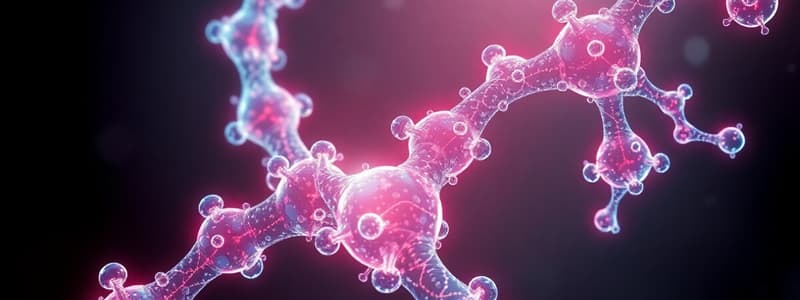Podcast
Questions and Answers
What process breaks down polymers into monomers?
What process breaks down polymers into monomers?
- Dehydration synthesis
- Phosphorylation
- Polymerization
- Hydrolysis (correct)
What is produced when ATP is converted to ADP?
What is produced when ATP is converted to ADP?
- Oxygen is consumed
- Energy is released (correct)
- Carbon dioxide is released
- Energy is absorbed
Which of the following best describes a saturated fatty acid?
Which of the following best describes a saturated fatty acid?
- Has the maximum number of hydrogen atoms (correct)
- Lacks hydrogen atoms
- Is typically liquid at room temperature
- Contains one or more double bonds
How do carbohydrates and lipids compare in function?
How do carbohydrates and lipids compare in function?
What structure forms the 'rungs' of the DNA ladder?
What structure forms the 'rungs' of the DNA ladder?
What defines an isotope of an element?
What defines an isotope of an element?
Which type of bond is primarily formed by the sharing of electrons between atoms?
Which type of bond is primarily formed by the sharing of electrons between atoms?
Why are some substances considered hydrophilic?
Why are some substances considered hydrophilic?
Which biomolecule is primarily used for energy storage in animals?
Which biomolecule is primarily used for energy storage in animals?
What distinguishes amphipathic molecules from other types of molecules?
What distinguishes amphipathic molecules from other types of molecules?
Which of the following best describes the term 'monomer'?
Which of the following best describes the term 'monomer'?
What is a key feature of substances that exhibit cohesion?
What is a key feature of substances that exhibit cohesion?
What do ionic bonds primarily result from?
What do ionic bonds primarily result from?
Flashcards
Isotopes
Isotopes
Atoms of the same element that have the same number of protons but different numbers of neutrons.
Allotropes
Allotropes
Different structural forms of the same element in the same physical state.
Polar
Polar
A molecule with a slightly positive end and a slightly negative end, due to uneven sharing of electrons.
Ionic Bond
Ionic Bond
Signup and view all the flashcards
Covalent Bond
Covalent Bond
Signup and view all the flashcards
Intramolecular Force
Intramolecular Force
Signup and view all the flashcards
Intermolecular Force
Intermolecular Force
Signup and view all the flashcards
Specific Heat Capacity
Specific Heat Capacity
Signup and view all the flashcards
Polymer Breakdown vs. Synthesis
Polymer Breakdown vs. Synthesis
Signup and view all the flashcards
ATP to ADP
ATP to ADP
Signup and view all the flashcards
Saturated vs. Unsaturated Fatty Acids
Saturated vs. Unsaturated Fatty Acids
Signup and view all the flashcards
Buffers
Buffers
Signup and view all the flashcards
Amino Acid Structure and Protein Function
Amino Acid Structure and Protein Function
Signup and view all the flashcards




